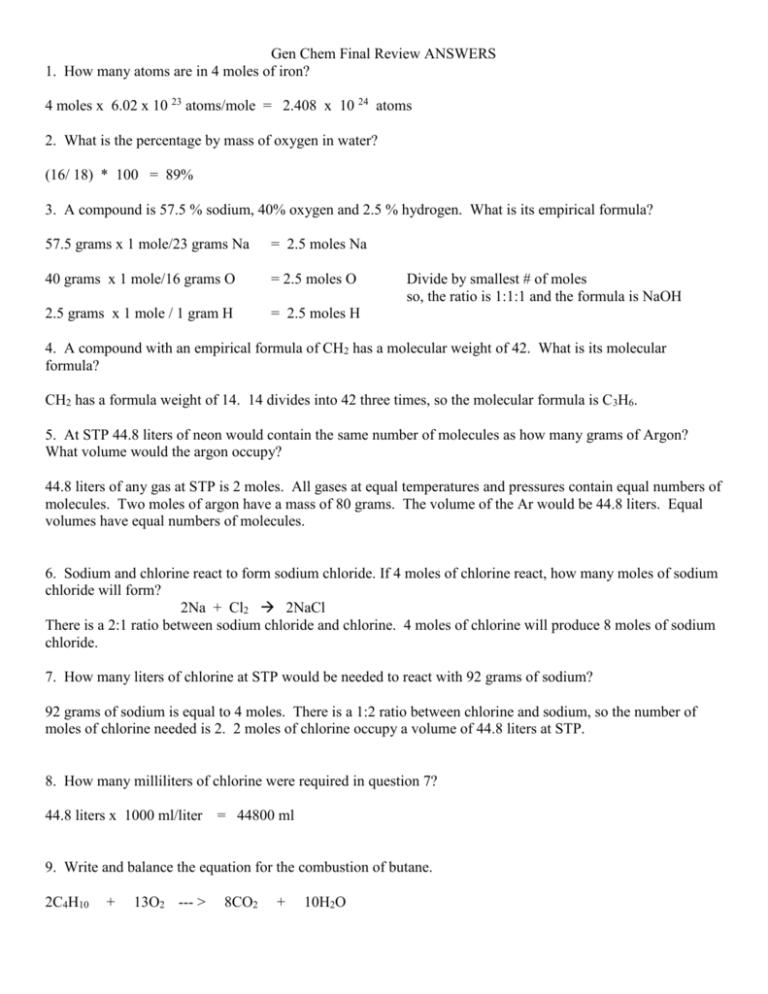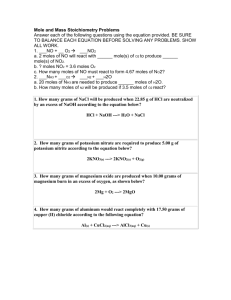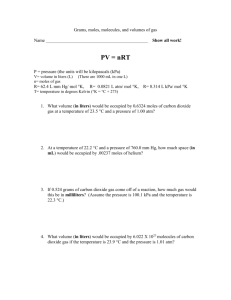1 - School District of Clayton
advertisement

Gen Chem Final Review ANSWERS 1. How many atoms are in 4 moles of iron? 4 moles x 6.02 x 10 23 atoms/mole = 2.408 x 10 24 atoms 2. What is the percentage by mass of oxygen in water? (16/ 18) * 100 = 89% 3. A compound is 57.5 % sodium, 40% oxygen and 2.5 % hydrogen. What is its empirical formula? 57.5 grams x 1 mole/23 grams Na = 2.5 moles Na 40 grams x 1 mole/16 grams O = 2.5 moles O 2.5 grams x 1 mole / 1 gram H = 2.5 moles H Divide by smallest # of moles so, the ratio is 1:1:1 and the formula is NaOH 4. A compound with an empirical formula of CH2 has a molecular weight of 42. What is its molecular formula? CH2 has a formula weight of 14. 14 divides into 42 three times, so the molecular formula is C3H6. 5. At STP 44.8 liters of neon would contain the same number of molecules as how many grams of Argon? What volume would the argon occupy? 44.8 liters of any gas at STP is 2 moles. All gases at equal temperatures and pressures contain equal numbers of molecules. Two moles of argon have a mass of 80 grams. The volume of the Ar would be 44.8 liters. Equal volumes have equal numbers of molecules. 6. Sodium and chlorine react to form sodium chloride. If 4 moles of chlorine react, how many moles of sodium chloride will form? 2Na + Cl2 2NaCl There is a 2:1 ratio between sodium chloride and chlorine. 4 moles of chlorine will produce 8 moles of sodium chloride. 7. How many liters of chlorine at STP would be needed to react with 92 grams of sodium? 92 grams of sodium is equal to 4 moles. There is a 1:2 ratio between chlorine and sodium, so the number of moles of chlorine needed is 2. 2 moles of chlorine occupy a volume of 44.8 liters at STP. 8. How many milliliters of chlorine were required in question 7? 44.8 liters x 1000 ml/liter = 44800 ml 9. Write and balance the equation for the combustion of butane. 2C4H10 + 13O2 --- > 8CO2 + 10H2O 10. If 232.0 grams of butane are combined with 192 grams of oxygen and a reaction occurs, how many grams of water will form? You need 2 stoichs because you have been given 2 givens. One from 232.0g of butane to g of water. The other from 192g Oxygen to water. Whichever given you the smaller number is the lim. reactant. Here, Oxygen produces 8.3g water and so 192g of oxygen is the lim. reactant. 11. If the reaction in number 9 was performed and 2 liters of carbon dioxide were produced at STP, what was the percent yield? Based on 12 moles of oxygen being limiting, there should be 7.38 moles of carbon dioxide formed. 2 / 7.38 gives a yield of 27% 12. Write and balance the equation for the reaction of aluminum with hydrochloric acid. 2Al + 6HCl 2AlCl3 + 3H2 13. If you are given 108 grams of aluminum to react with 146 grams of HCl, what will be the limiting reactant? 108 grams of Al = 4 moles 146 grams of HCl = 4 moles. You would need 12 moles of HCl to react with 4 moles of Al. Since you only have four moles, the HCl is limiting. Or, same situation as Q #10. 14. Convert 350 kPa to mm Hg. 350 kPa x 760 mmHg/101.3 kPa = 2626 mm Hg 15. A sample of gas occupies 4 liters at 25 C and 200 kPa. What will its volume be at STP? 4 liters x 273 K/298K x 200 kPa/101.3 kPa 16. What is the volume of a 4 mole sample of He at 200 K and 102 kPa. PV = nRT (102 kPa) (V) = 4 mole ( 8.31 lkPa/moleK) (200 K) V = 65.2 liters 17. What is the mass of 2 liters of ammonia at 222 kPa and 125 C? PV = nRT (222 kPa) (2 liters) = n (8.31 liter kPa/moleK) ( 298K) n = .179 moles x 17 grams NH3/mole = 3.04 grams 18. How does the volume of at gas relate to temperature? to Pressure? Volume up, Temperature up (Direct) Volume up, Pressure down (Inverse) 19. How is temperature related to average kinetic energy? Temperature is average kinetic energy (average movement of molecules) 20. What phase change does solid carbon dioxide (dry ice) undergo at 1 atm and 25 C? sublimation---the change from solid to gas 21. Why do your ears “pop” when you go up a mountain? Air pressure is less as you move up in the atmosphere. The air inside of you tries to get out, so your ears pop as it leaves. 22. Does a gas diffuse faster, or slower at a high temperature? Molecules move faster when they are hot, so gases diffuse faster when they are at a high temperature. 23. What is Boyle’s law? Volume is inversely proportional to pressure. 24. What is the molecular weight of a gas that has a mass of .5 grams in a volume of 1 liter at STP? PV = M/MW RT (101.3 kPa) (1 liter) = (.5 grams /MW) (8.31 liter Kpa/mole K) (273 K) MW = 11.2 grams/mole 25. If you dissolve salt in a beaker of water and the temperature goes up, was the solution process exothermic or endothermic? Exothermic. The temperature went up, so heat must have been released. 26. How many joules of energy are released when 40 grams of water cool from 40 C to 20 C? ∆ H = m Cp ∆T = 40 grams ( 4.18 J/gC) (20 C) = 3344 J 27. How many joules of energy are needed to melt 20 grams of water (ice) at its melting point. The heat of fusion of water is 80 cal/gram and 4.18 joules = 1 calorie. ∆H = m Hf = 20 grams ( 80 cal/gram0 = 1600 calories 1600 calories x 4.18 J/calorie = 6688 Joules 28. 25 grams of a metal at 98 C are put into a container of 50.0 grams of water at 18 C. The temp. of the water rises to 25 C. What was the specific heat capacity of the metal? Cp water = 4.18 J/gC The heat gained by the water Cp of the metal ∆ H = m Cp ∆T = 50 grams ( 4.18 J/gC) 7 C = 1463 Joules gained by the water ∆ H = m Cp ∆T 1463 joules = 25 grams ( Cp ) 73 C Cp = .802 joules/gramC 29. The ∆H for the combustion of ethane is –3120 kJ. If 100.0 grams are burned, what quantity of heat is released? 2C2H6 + 7O2 4CO2 + 6H2O 100 grams ethane x 1 mole/30 grams = 3.33 moles of ethane 3.33 moles of ethane x –3120 kJ/mole = 10389.6 kJ of heat released. 30. Was the reaction endothermic or exothermic? Exothermic. Heat was released. 31. If 400.0 kJ of energy are put into 50 grams of water at 25 C, what will be the final temperature of the water? ∆H = m Cp ∆T 400000 J = 50 ( 4.18 J/gC) ∆T ∆T = 1914 C The change in temp, ∆T, is equal to T final – T initial, so 1914 = Tf – 25 Tf = 1939 C 32. How do you determine whether a bond is ionic, polar covalent or non polar covalent? Look up the electronegativities of the atoms. The larger the difference, the more ionic the bond is. The smaller the difference, the more covalent the bond is. 33. What type of bond involves equal sharing of electrons? Non polar covalent 34. How do the electronegativities of the atoms in a non-polar bond compare to each other? They are nearly the same. 35. What is the formula of an ionic compound between magnesium and nitrogen? Mg3N2 36. How many double bonds are in the Lewis dot diagram of carbon dioxide? O=C=O (unshared pairs not shown) TWO 37. What is the electron domain geometry of ammonia (NH3)? Tetrahedral. The shape however is pyramidal 38. How many double bonds are in the carbonate ion (CO3-2) ONE 39. If two molecules are similar in size, would a polar or a non-polar molecule evaporate faster? Polar molecules stick together more, so nonpolar molecules will evaporate faster. 40. Between non-polar molecules, do big molecules or small molecules stick together better? Big molecules have longer lasting London dispersion forces (temporary dipoles), so they stick together more. 41. What is a “unsaturated hydrocarbon?” A hydrocarbon with at least one double or triple bond. 42. What three elements would you expect to find in an amine? C, H, and N 43. What functional group would you expect to find in propanol? R-OH 44. Differentiate between alkanes, alkenes and alkynes. Alkanes --- all single bonds Alkenes --- one double bond Alkynes --- one triple bond 45. How many moles are in 4 liters of 4 M NaOH? 4 liters x 4 moles/liter = 16 moles 46. What is the molarity of a solution containing 120 grams of NaOH in 4 liters of solution? Find moles of NaOH 120 grams x 1 mole/40 grams = 3 moles of NaOH Divide moles by liters to get molarity 3 moles / 4 liters = .75 M 47. What is the pH range of a base? Greater than 7 - 14 48. What is the pH of a solution with a hydronium ion concentration of .0001 M? pH = -log [H3O+] - log .0001 = 4 49. How do you identify a base by looking at a chemical formula? Bases contain a hydroxide ion. 50. If 25 ml of an acid HA are required to neutralize 35 ml of .2 M NaOH, what was the molarity of the acid? HA + NaOH NaA + HOH .035 liters x .2 moles/liter = .007 moles of NaOH. There is a 1:1 ratio in the balanced equation, so there were .007 moles of HA The molarity is equal to moles/ liters, so .007/ .025 liters = .28 M 51. What do acids donate to bases? Protons 52. What is an electrolyte? A solution that contains ions. Ions are necessary for a solution to conduct electricity. 53. What is equilibrium? Two processes occurring in opposite directions at EQUAL RATES. 54. How do equilibrium systems differ from the chemical reactions that we studied for most of the year? Equilibrium reactions do not completely react. 55. For the reaction A + B <-> C, What effect will an increase in B have on A and C? An increase in B will shift the equilibrium to the right. This will make more of C and A will go down as it is used to make C. 56. When metals combine with oxygen, what does their charge go up, or down? Metals lose electrons (OXIDIZATION) to the oxygen, so their charge goes up. 57. In the reaction between chlorine and sodium iodide, what reactant is oxidized? Cl2 + 2NaI 2NaCl + I2 Chlorine starts as a reactant with a charge of zero. Its charge goes to –1 on the right side. Iodine starts as a reactant with a charge of –1. Its charge goes to zero on the right side. The IODINE is OXIDIZED ---- charge went up, electrons were lost. 58. What type particle can be accelerated in a magnetic field? A particle with a charge. ---- Alpha (helium nucleus), Beta (electron), protons 59. When salt is put into water, what effect does it have on the liquid range of the water? The liquid range is expanded as the freezing point is lowered and the boiling point is raised. 60. What is the difference between nuclear fusion and nuclear fission? Nuclear fusion involves two atoms becoming one. Fission is the splitting of atoms.







